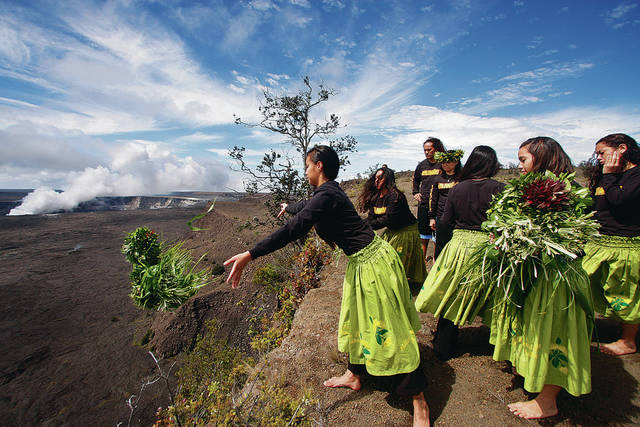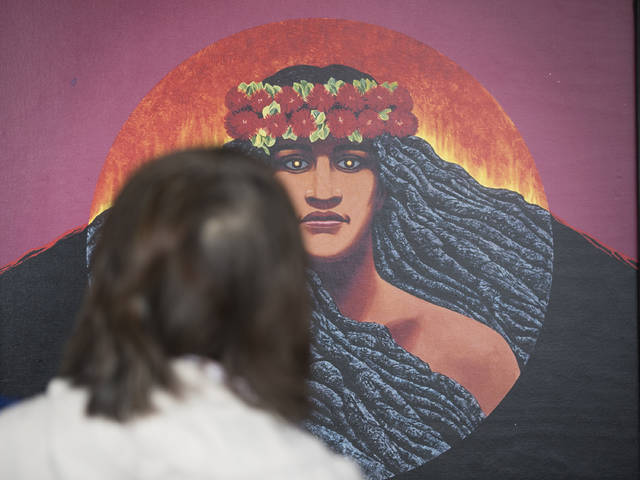Many accept their fate at the hands of Pele

DENNIS ODA / 2009
Before the annual Merrie Monarch Festival competition in Hilo, many halau visit Halemaumau crater to honor Pele. At left, members of Halau Ka Liko Pua O Kalaniakea throw lei and ti leaves into the crater after performing a chant and hula.

CINDY ELLEN RUSSELL / CRUSSELL@STARADVERTISER.COM
A portrait of Pelehonuamea by artist, historian and author Herb Kane is displayed inside the Thomas A. Jaggar Museum.


As threats from the latest Kilauea eruptions continue in Puna, many speak of the dramatic lava flows as the work of Pele, the goddess of fire and volcanoes.
These Native Hawaiians and other Hawaii residents accept the volcanic activity that has consumed 36 structures and displaced hundreds of residents as demonstrations of Pele’s power and beauty. And there is no way to stop her.
Pelehonuamea, or Pele of the sacred earth, is also known as “ka wahine ai honua,” woman who devours the land. She is also called Madame Pele or Tutu Pele.
“I usually use Tutu Pele because she’s an ancestor to me and one of our family aumakua, or family guardian, so we have great respect for her,” said Lilikala Kame‘eleihiwa, a professor at the Kamakakuokalani Center for Hawaiian Studies on the University of Hawaii’s Manoa campus. “We have a personal relationship with Pele.”
RELATED
>> County shuts down vacation rentals as residents are left to deal with more lava outbreaks
>> Harry Kim remains a caring, competent voice in crises
>> Photos: Residents prepare for the worst as more fissures open
>> Photos: Tourists stay despite eruption threats from Kilauea
Don't miss out on what's happening!
Stay in touch with breaking news, as it happens, conveniently in your email inbox. It's FREE!
—
* Star-Advertiser Kilauea volcano coverage
* Video Playlist: Kilauea Volcano
The central figure of many chants, mele and hula, Pele is an akua or divine element, represented by volcanoes, lava and flowing fire. She is portrayed as an all-powerful force that dwells at Halemaumau, the pit crater inside the Kilauea summit caldera located within Hawai‘i Volcanoes National Park.
“Pelehonuamea is her honorific name,” Kame‘eleihiwa said. “Honuamea is not just land, honua is also the earth. Aina is the land you eat from. Honua is earth, including the oceans. Mea means sacred, but also means (the color) red.”
With Saturday’s reports of two more eruptions in the lower Puna area of the East Rift Zone, Pele appears to be on the move. Hawaii National Guard personnel stand ready to evacuate up to 2,000 residents of Kapoho and Kalapana at a moment’s notice.
Since a series of fissures erupted May 3, three dozen homes and other structures in the Leilani Estates and Lanipuna Gardens area have been destroyed, causing an estimated 1,800 residents to evacuate their homes and covering 117 acres with lava. Hawaii County Civil Defense has warned of the possibility of steam-driven explosions of rock and ash at the Kilauea summit that could launch boulders more than a half-mile away with little warning.
A destructive, creative force
Epic stories tell of Pele as a child born to Haumea in Tahiti. After a fight with her sister Namaka, goddess of the sea, Pele embarked on a journey, accompanied by family, in search of a new home. She traveled from Kauai down the island chain to Hawaii island. There, she found a home at the pit of Kilauea.
She is the force behind Kilauea’s eruptions including the latest outbreak, which has been ongoing since 1983. She is powerful, and she is unpredictable, according to Hawaiian myth.
As she sows destruction, Pele also opens new paths for creation, according to Oahu kumu hula Vicky Holt Takamine.
“She is also the creator of new lands and islands,” Takamine said. “She helped to create the different formations. For Oahu, in particular, she’s responsible for Punchbowl Crater, for Leahi (Diamond Head), for visiting all the islands and stretching the land a lot farther.”
For Takamine, the volcanic process is a sort of “cleansing of land” from illnesses such as rapid ohia death, the fungal blight killing indigenous ohia lehua trees, and the invasive species affecting Hawaii’s natural and cultural resources. She said the cleansing leads to a rebirth of new lands and formations.
After a lava flow, the first plants to grow are native species including ohia lehua and kupukupu ferns, Takamine said.
Earthquakes and lightning are all associated with Pele’s family, as are volcanic ash, winds and rains, she said. Pele’s sisters, including Hi‘iaka and her friend Hopoe, are inspirations for songs and dances of creation.
The movement of lava also serves as inspiration for movement, song composition and choreography, according to Takamine.
“I’ve been watching the lava fountains and how bombastic that is and how the lava moves,” she said. “There’s the slow moving lava, pahoehoe, and then there’s the aa that’s crumbly, and it has a different movement to it … . Those are all inspiring for movement.”
Kalei Nu‘uhiwa, a cultural researcher at the Edith Kanaka‘ole Foundation in Hilo, describes the eruptions as “myth coming to life.” Chants she learned talk about the various stages of eruption attributed to Pele, who is one of a plethora of deities contributing to volcanism.
The chants recorded natural phenomena throughout history.
“The whole event makes me think of those legends, or observations, that were noted and added to chants to make sure we would remember,” she said. “And then those chants are timeless in the way we can see those same things happening today, even though those chants are hundreds of years old.”
The ideology is that you surrender, knowing you’re in Pele’s land, Nu‘uhiwa said.
“In this case, akua can give you life or give you death,” she said. “It’s the idea of Pele herself giving us new land … . That’s her function and sometimes it’s not done in a nice form. Sometimes it’s destructive and it destroys things. In the end, we benefit from it all.”
Gifts for the goddess
Kame‘eleihiwa said those who feel they have a relationship to Pele may put markers at the boundaries of their property hoping she will spare it. Others may clean out their homes and leave hookupu, or gifts, for her.
Many hula halau trek up to Halemaumau crater before the annual Merrie Monarch Festival competition held in Hilo every spring to pay homage to Pele, offering her lei and hookupu wrapped in ti leaves and performing chants and hula.
“I feel a great sadness for them,” Kame‘eleihiwa said of those who lost their homes and have had to evacuate.
The old place name for Leilani Estates is Keahi-a-Laka, she said, which historically is known as a place where lava has flowed in the past. There are chants about the area being a well-worn path for lava, she said.
Before rebuilding homes in the area again, Kame‘eleihiwa said she thinks it would be wise to take a look at the place names and history.
Kame‘eleihiwa was on her way to Tahiti this weekend to visit the birthplace of Pele, where she planned to offer a prayer and a gift of Hawaiian salt.
“If there were no houses in her way, we would all be admiring her dancing down the mountain,” Kame‘eleihiwa said.




